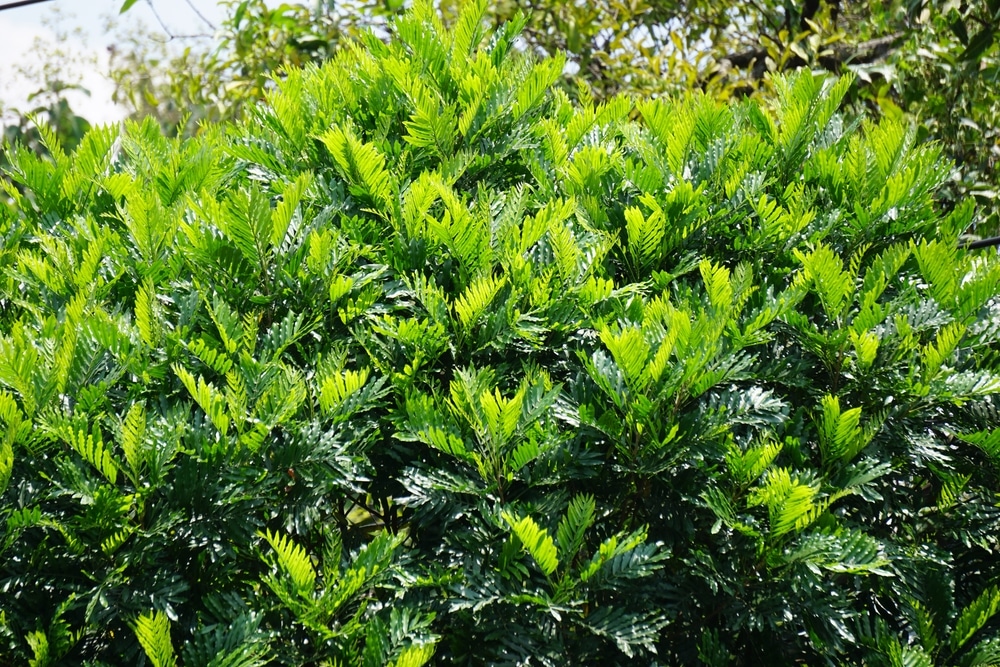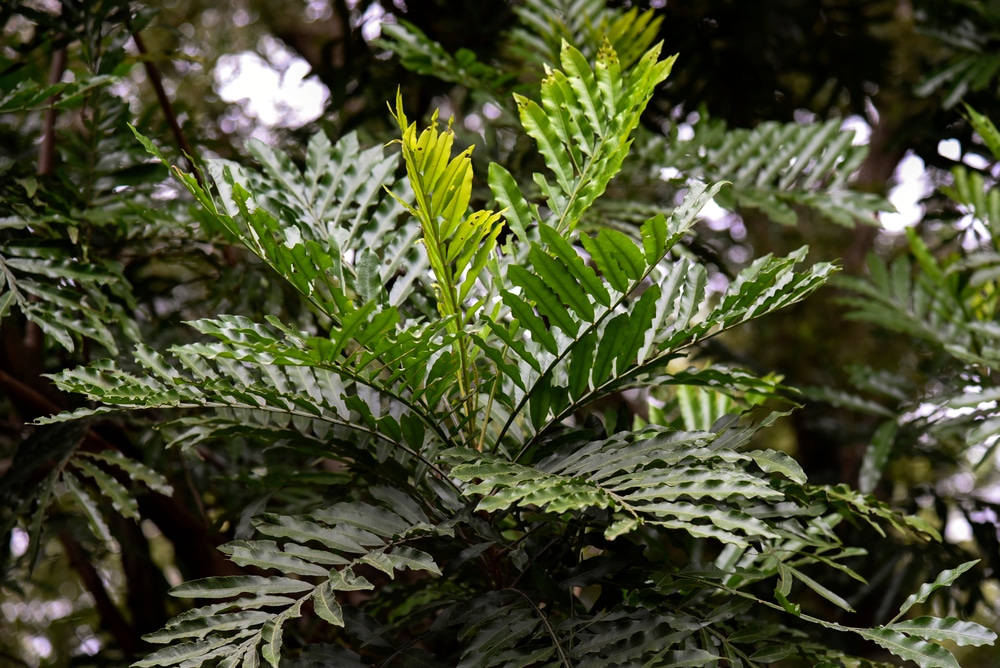Known for its striking naturally rounded crown and eye-catching fern-like foliage, the Japanese fern tree makes an excellent addition to any lawn. A beauty to behold in any season, this unique tree is sure to add curb appeal to your home.
But how do you care for a Japanese fern tree? Keep reading to learn everything you need to know about this special tree, from its watering needs to the best way to propagate it.

The following are the most important facts about the Japanese fern tree:
| Botanical Name | Filicium decipiens |
| Common Name | Fern Tree, Thika Palm |
| Plant Type | Perennial |
| Flower Color | <1″, White, Inconspicuous |
| Size When Mature | 15-35 feet tall, 15-25ft. wide |
| Bloom Time | Later winter to Early Spring |
| Sun Requirements | Full sun, Partial Sun |
| USDA Hardiness Zones | 10-12 |
| Soil PH Range | 6.1-7.3 |
| Soil Type | Slightly Acidic-Neutral, Well-draining |
| Water Needs | Medium |
| Native Area | Asia, Africa |
What you Need to Know About The Japanese Fern Tree
Scientifically known as Filicium decipiens, the Japanese fern tree is a slow-to-medium growing evergreen that can reach up to 15-35 feet in height and 15-25 feet in width.
In its native regions, which are specifically Asia and Africa, this tree has been reported to attain impressive heights of up to 88ft. What makes this tree strikingly beautiful is the short trunk that holds a dense and neatly-shaped crown.
The naturally rounded crown is made up of beautiful, large fern-like leaves that grow up to 1.3 ft in length. There are green, glossy, elongated, and oval-shaped leaflets that take an opposite arrangement on the main leaf.
While this tree has the word “fern” in its name, it’s not a true fan. The name “fern” tree is a misnomer and is attributed to the similarity in shape between its leaves and those of a true fern.
One thing that’s certain is that the Japanese fern tree is an ornamental tree that’s loved for its aesthetic value. And being an evergreen tree, your admiration for this plant will not be limited to any particular season as it will look good all year round.
Additionally, this tree also blooms in the late winter to spring. And even though the small, white, clustered flowers are hardly visible since they are hidden by the foliage, they still manage to add a touch of elegance to this plant.
As if the wonders of this tree are not enough, it also produces small, green, oval fruits that are purple-reddish in their ripened state. There are no reports of this tree being toxic to either humans, dogs, or cats.
How to Care for Your Japanese Fern Tree
The good news is that the Japanese fern tree is relatively easy to care for. Here’s everything you need to know about growing and caring for a thriving Japanese fern tree.
– Light
This tree does best in areas that get a lot of direct sunlight. You will want to have your plant situated in an area that receives not less than eight hours of sunlight every day. More sunlight is better.
If you live in unpleasantly hot or dry regions, however, the plant can do better with a little bit of shade, especially in the afternoon.
– Soil Needs
The ideal soil for your Japanese fern tree is moist, well-draining soil. The soil should be moderately acidic to alkaline. The pH should fall within the range of 6.1-7.3 for the best results.
Planting your tree in soil that is rich in organic matter will be a huge benefit to the plant. This is because organic matter help to aerate the soil and make it more porous.
Amendments like compost or peat moss can be worked into the planting site before you introduce your tree.
– Watering Needs
For optimal growth, your Japanese fern tree will require that you water it on a regular basis. Just make sure not to soak it. To achieve that, it is recommended that you allow the soil around your tree to dry out a bit between watering sessions.
– Temperature Requirements
This tree thrives best in USDA hardiness regions 10-12. As such, it should be planted in warm, tropical regions that are not frosty. The annual lows should be within the range of 55.4-77°F, whereas the annual highs should fall within the ranges of 80.6-95°F.
Since this tree is a huge fan of humidity, it will appreciate being planted in places with above-average humidity.
– Fertilizer
The best fertilizer to use on your fern tree is granular fertilizer, which should be applied preferably in the spring, summer, and fall. You can still feed your plant in the winter, but it’s really not necessary since the plant will be in a semi-dormant state.
– Common Diseases
One fascinating fact about this tree is that it’s not prone to the major pests and diseases that affect other trees. Should you see a change in the foliage hue, it’s either a result of extreme cold or iron deficiency.
Additionally, you might experience a problem with root rot if you plant your Japanese fern tree in soils that are poorly drained.
Japanese Fern Tree Propagation
The most viable way to propagate the Japanese fern tree is by seeds. And since these seeds lose their viability quite fast, it is highly recommended that you sow them as soon as you harvest them.
The process of seed propagation is not so complicated, so natural germination should give you good results. Just plant your seeds during the fall season and by spring, they should have germinated.
The most important tips for propagation are:
- Avoid planting the seeds too deep
- Soak your fern tree seeds for approximately 24 hours in water at room temperature
- Plant the seeds in well-drained soil
- Keep the soil moist, not soggy

